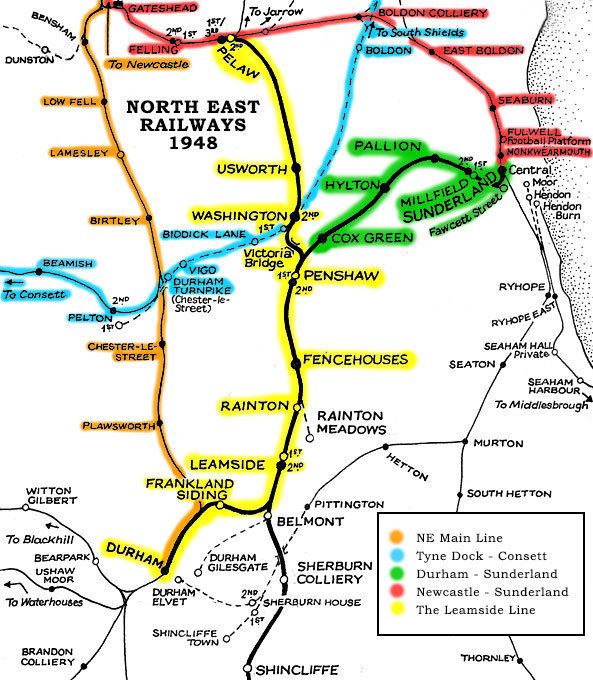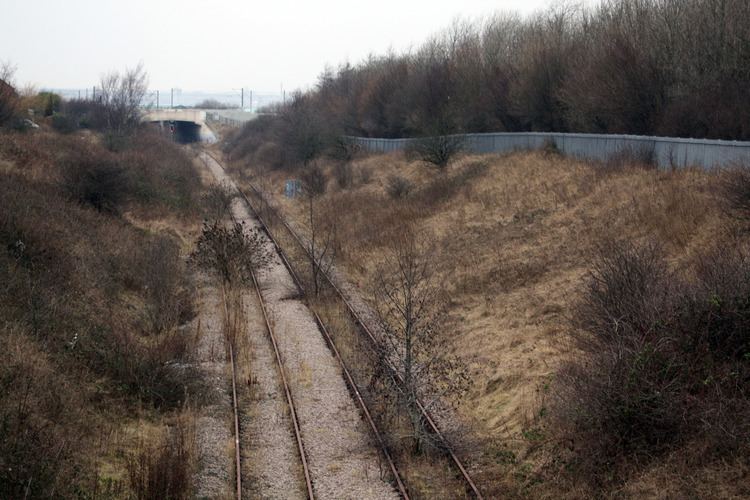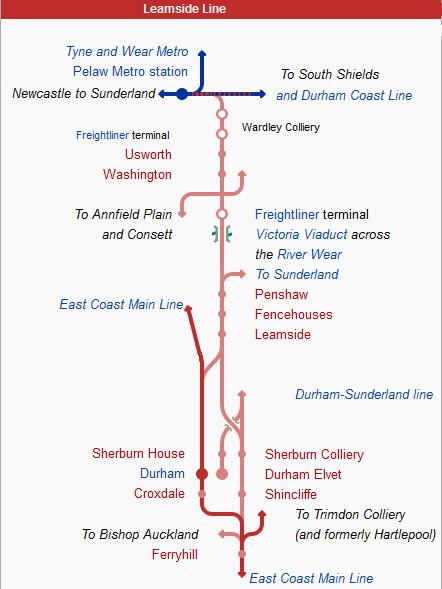 | ||
Leamside line fencehouses removed railway tracks
The Leamside line (originally part of the Durham Junction Railway) is a railway line in the North East of England, branching off from the main East Coast Main Line (ECML) at Tursdale in County Durham, and continuing north through Washington and Wardley, finally joining the Newcastle upon Tyne to Sunderland line at Pelaw.
Contents
- Leamside line fencehouses removed railway tracks
- The leamside line pelaw junction to usworth as at october 2012
- History
- The line today
- Re opening plans
- Track removal
- References

It is currently out of use, having been mothballed by British Rail in 1991 after the closure of the Freightliner freight terminal at Follingsby, near Washington, which was the recipient of most of the line's traffic in its last years. A short section of the line from Pelaw Junction remained in operation for a number of years, serving the open-cast coal mine at Wardley, but this too has now closed.

The leamside line pelaw junction to usworth as at october 2012
History

The first section of the line was opened by the Durham Junction Railway on 24 August 1838 between Washington, on the Stanhope & Tyne Railway, and Rainton Meadows. The Newcastle & Darlington Junction Railway bought the railway in 1843 and used it as part of its route between Darlington and Newcastle from 18 June 1844. Trains traveled via Brockley Whins until the York, Newcastle and Berwick Railway, the successor of the Newcastle & Darlington Junction, opened the direct line between Washington and Pelaw on 1 September 1849.

The stone arch Victoria Viaduct over the river Wear is inspired by the design of the Alcántara Bridge in Spain. The rails pass 135 feet (41 m) over the valley, carried on four arches, two of span 160 and 144 feet (49 and 44 m), and two of span 100 feet (30 m). It constituted part of the original East Coast Main Line route from Edinburgh to London, eventually being incorporated into the North Eastern Railway. The line's main source of revenue, as with most of the early railways, was mineral traffic, principally coal from the Durham coalfield. The line was linked to many private colliery branch lines and wagonways.
During the line's period of operation, passenger stations served were: Usworth; Washington; Penshaw; Fencehouses; Leamside; Sherburn; and Shincliffe.
The line was part of the East Coast Main Line until 1872 when the route was bypassed by the NER's Bishop Auckland to Gateshead line and Croxdale link, which became part of the ECML. Thereafter it continued to carry local passenger services and freight traffic, as well as serving as a useful diversionary route from the ECML.
Passenger services between Leamside and Ferryhill were withdrawn in 1941 and Leamside station closed in 1953. Usworth and Washington closed on 9 September 1963. The last regular passenger service was withdrawn in May 1964 as part of the infamous Beeching Axe although, in its latter days, this had only consisted of an early morning 'newspaper' train from Newcastle to Fencehouses and Durham only and a single workers' return service from Newcastle to Washington on Mondays to Fridays. Coal and other freight continued to be carried until the gradual closure of the Durham coalfield in the 1970s and 1980s resulted in a severe drop in the line's traffic. It was mothballed in 1991.
South of Victoria Viaduct, the line merged with the direct Durham to Sunderland Line for a short distance. This also fell to the Beeching Axe in 1964.
The line today
After mothballing, the double track was reduced to a single line in some places, and the track was severed at some level crossings along the line. Initially, its engineering features remained intact but the embankment which carries the line over Moors Burn, 500 yards to the north of the site of Fencehouses station, had partially collapsed, leaving the former down track suspended.(54.850776°N 1.507447°W / 54.850776; -1.507447)
Part of the Durham to Sunderland line that left the Leamside line near the south-east end of the Victoria Viaduct was brought back into use in 2002 for the Sunderland Extension of the Tyne and Wear Metro, terminating at South Hylton, around 3 miles from the former junction with the Leamside line.
Around one mile (1.6 km) of track to the south of Penshaw was stolen in 2003 and would have had to be replaced if the line were to eventually reopen. This theft, which took place over a six-day period using a gang of workers who were unaware that the work was illegal, substantially raised the costs of reopening the route.
Substantial parts of the line and infrastructure were also missing from around the former Usworth station which also became severely overgrown.
Re-opening plans
The North East Combined Authority has approved ambitious plans to create a joined-up rail and Metro network – as well as replacing ageing trains for a newer fleet. The strategy, approved by NECA on 19 July 2016, identifies a network of disused or under-used rail routes across the region which could benefit from new or better services. NECA says it can connect Belmont in Durham with Fencehouses, Penshaw, Sunderland, South Hylton, Washington, Pelaw, South Shields and Newcastle by opening up the old Leamside line.
On 4 December 2006, Tyne and Wear Passenger Transport Authority announced that it had commissioned a study into the future use of the line, with a view to possible re-opening as a suburban railway linking into the local transport network. The next day, it was announced that Network Rail had also signed up to the study, although current plans for removal of the track (see below) would still proceed. The study concluded in 2008 that the most appropriate use of the line would be to carry a regional service linking the Tees Valley and Tyne and Wear regions, with the highest level of wider economic benefits achieved by minimising the journey time between the end points, rather than serving a large number of intermediate stations. According to the report, passenger demand would be great enough to produce a farebox revenue of over £2 million per year. Such a service would also allow scope for freight trains to operate.
The line had been briefly considered in 2000 for reopening by Railtrack as a diversionary freight route to take the burden from the congested ECML. A number of studies have advocated re-opening the line, for example The vision for passenger rail services in the Tees Valley. Re-opening the line would provide economic benefits to areas depressed since the demise of the coal mining industry. However, these plans were put on hold.
Durham County Council's Local Transport Plan (LTP) indicates that the Council supports passenger traffic return to the Leamside line, and would promote the service. See Railwatch for more details.
If the Leamside line is opened to passenger traffic, it would lead to the reopening of several railway stations along the route. The Select Committee on Transport, Local Government and the Regions has expressed concern at the delays in determining the future of this line.
On 15 June 2009, the Association of Train Operating Companies (ATOC) included Washington as one of a number of towns in the UK that would benefit from the reinstatement of existing rail links that were closed or mothballed in the second half of the twentieth century. This would entail the opening of all or part of the Leamside line either as part of the National Rail network, or as an extension of the Tyne and Wear Metro. Both systems could potentially be connected at the northern end of the line at Pelaw Junction, while the Leamside line continues to link with the East Coast Main Line to the south. A third option would be to form a loop line with the Sunderland Metro extension, which runs on the trackbed of the Durham to Sunderland Line as far as South Hylton, with the disused trackbed continuing to its junction with the Leamside line. Although the historical junction only allowed trains to merge onto the Leamside line in a southerly direction, space is available to create a short section joining the two tracks in the other direction.
Re-opening of the line has been suggested by many stakeholders including the Tyne and Wear Passenger Transport Authority (on 28 January 2010), the Association of Train Operating Companies and Durham City Council. The case for re-opening the line includes providing a Tyneside to Teesside commuter express train between Newcastle Central Station and Middlesbrough which, according to the 2007 report produced by AECOM Faber Maunsell, would have a passenger patronage level of over 700,000 per annum with 90,000 of those utilising Park and Ride facilities at Washington and Durham (Belmont). In addition, the route would become a strategic diversionary route from the East Coast Main Line and could accommodate expansion of the Tyne and Wear Metro system between Washington and Pelaw.
TyneTees Express railway stations, as stated by the Tyne and Wear Passenger Transport Authority, would include: Newcastle Central Station; East Gateshead (Park Lane); Washington Parkway (Glover Road); Washington (Station Road); Penshaw (Coxgreen Road); Fencehouses (level crossing); Durham Parkway (Belmont); Ferryhill; Stockton; Thornaby; and Middlesbrough.
Track removal
On 14 September 2006, Network Rail announced plans to lift the track along the full length of the line. It was maintained that the track, after 15 years out of use, would need replacing anyway if the line was ever to re-open, and that this move would have no implications for any future use of the railway. The company also pledged that all bridges would be left in place, with no sales of land attached to the line. A former British Rail engineer, who oversaw a major upgrade of the line just two years before its closure, has countered Network Rail's claims, saying that the track is still in excellent condition and would need only minimal refurbishment to bring it back into use. In July 2010 the government said they have no plans to reopen the line, but the land the track runs on will not be sold. The track remained largely in place until its complete removal early in 2013.
